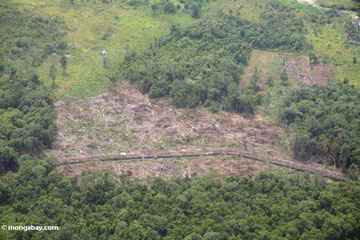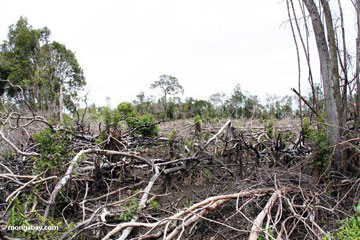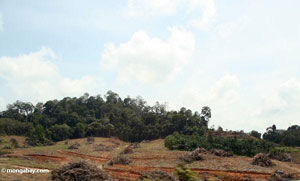Palm oil doesn’t have to be bad for the environment
Palm oil doesn’t have to be bad for the environment
Rhett A. Butler, mongabay.com
April 4, 2007 [part 1 | part 2]
As traditionally practiced in Southeast Asia, oil-palm cultivation is responsible for widespread deforestation that reduces biodiversity, degrades important ecological services, worsens climate change, and traps workers in inequitable conditions sometimes analogous to slavery. This doesn’t have to be the case. Following examples set forth by the Roundtable on Sustainable Palm Oil and firms like Golden Hope Plantations Berhad, a Malaysian palm-oil producer, oil palm can be cultivated in a manner that helps mitigate climate change, preserves biodiversity, and brings economic opportunities to desperately poor rural populations.
Conserving natural forests
The most important step in reducing the environmental impact of palm oil is banning the establishment of oil-palm plantations in natural forest areas and peatlands. Oil-palm cultivation in both these areas does more harm than good, either through the reduction of biodiversity and ecological services (natural forests) or through the release of massive amounts of carbon dioxide (peatland conversion). Oil-palm plantations should be encouraged on existing agricultural lands and areas that have been heavily degraded and deforested.
Retaining natural forest cover is particularly important near oil-palm plantations where forest serves as a refuge for predators of oil-palm pests and can help reduce soil erosion on hillsides and water catchment areas, while slowing and reducing water runoff.
Minimizing haze
  Rainforest clearing for an oil palm plantation in Borneo. Seen from above and at ground level. Photos by Rhett A. Butler. |
Every year a choking haze spreads across large parts of Southeast Asia. While most of this results from peatland and forest fires, some of the pollution is produced by vegetation burning on oil-palm plantations. This impact can be reduced using “zero burning replanting” techniques pioneered by Golden Hope Plantations.
Instead of burning stands of unproductive oil palm, Golden Hope cuts and shreds them and lets them decompose. This helps fertilize the soil for future crops—shortening the fallow period and lessening the need for chemical fertilizers—and reduces both “haze” and greenhouse-gas emissions. Further, under zero-burning techniques, land-clearing is cheaper ($300-400 per hectare saved in replanting costs) and independent of weather conditions. Concerns over increased risk of beetle infestation can be abated by using leguminous cover crops, which also fix nitrogen and enhance the soil.
Pest control
Monocultures in tropical climates often suffer from pest problems—oil-palm plantations are no exception. Generally, plantation owners are heavy users of pesticides that pollute waterways and affect local wildlife.
Golden Hope has taken a different approach. It has reduced its use of chemicals by focusing on biological control, including the use of beetles, birds, and fungi to deal with common oil-palm pathogens. Golden Hope builds owl boxes to attract rodent-eating barn owls and plants native tree species to draw bats and other insectivores. When pesticides are determined absolutely necessary, the company employs highly selective application of insecticides to control the worst outbreaks. Because it relies on early detection of pests, large-scale applications are rarely needed.
Palm-Oil Mill Effluent (POME)
|
Waste generated by the pressing of palm fruit during crude palm-oil production is a general problem for processors. While these compounds are non-toxic, they can’t safely by discharged into local waterways due to their high acidity. Golden Hope addresses this issue by treating raw POME with anaerobic bacteria that break the effluent into methane (which can be recaptured as fuel), carbon dioxide, and water. The company holds the treated POME for longer than average and uses it as a substitute for inorganic fertilizer. Golden Hope also composts empty fruit bunches and other wastes from the production process, further diminishing the need for petroleum-based fertilizers.
Other techniques
In many parts of Indonesia, where plantation expansion is the fastest, there are serious concerns over the impact of oil palm on the water table. Golden Hope tries to minimize this risk by carefully managing water use through reservoirs and irrigations systems. To cut erosion, the company uses terracing and creeping leguminous covers, which also improve soil biodiversity and fertility.
Reforestation
Golden Hope encourages reforestation in forested reserves, on steep slopes, and on land near catchment areas, using native species—especially those with commercial, medicinal, culinary, and ecological value. Regarding these planted areas, the company says it aims to “enhance their attractiveness and ability to sustain fauna diversity by planting food tree species already endemic in the areas” and “encouraging resting by migrating birds by building perches and retaining dead tall trees.”
Their effort seem to be paying off: surveys have recorded 268 species of flora and fauna, including 87 birds and 11 mammals, in oil-palm plantations. While this is lower than those found in primary or even secondary forest areas, it represents an improvement over barren land or other monocultures.
Expanding on these concepts for concessions in other parts of Malaysia and Indonesia, governments should encourage the recovery of developed secondary forests for recreation, biodiversity, and carbon value. Through some sort of carbon-trading or “avoided deforestation” mechanism, it may be possible to compensate these firms for forest conservation efforts. Beyond this direct monetary incentive, secondary forests can yield sustainable forest products and other ecological services for plantation workers and local communities.
Social Justice
Some of the biggest problems associated with palm oil production are social. While there is no doubt that oil-palm plantations provide much-needed employment opportunities in Indonesia—especially Borneo, which is used as an example in the next paragraphs—there are questions on the fairness of the existing system, which appears to sometimes lock small plantation owners into conditions akin to slavery.
Social Impact of Palm Oil in Borneo [source: mongabay.com]
Given the scarcity of timber in parts of Borneo, much of its population has few economic options at present. Oil palm seems to be the best alternative for communities that are just eking a living off rubber cultivation, subsistence rice farming, and fruit gardens. When a large agricultural firm enters an area, some community members are often eager to become part of an oil-palm plantation. Since these people lack legal title to their land, deals are often structured so that they acquire 2-3 hectares (5-8 acres) of land for oil-palm cultivation. They typically borrow some $3,000-6,000 (at 30 percent interest per year) from the parent firm for the seedlings, fertilizers, and other supplies. Because oil palm takes 3-4 years to bear fruit, the community members work as day laborers at $2.50 per day on mature plantations, according to Dr. Lisa Curran, a biologist who has spent more than 20 years in Borneo. In a series of papers, she has documented the emergence of oil-palm plantations on the island. While the community members are working in established plantations, their own plots generate no income but require fertilizers and pesticides, which are purchased from the oil-palm company. Once a plantation becomes productive, the average income for a two-hectare allotment is $682-900 per month. In the past, rubber and wood generated $350-1000 month, according to Curran. The low level of income, combined with large start-up costs and relatively high interest payments, virtually ensures that small holders will be perpetually indebted to the oil-palm company.
Curran said this debt, combined with almost total dependence on entities they barely trust, has a psychological impact on communities. Because there are no ways to contest actions by the company, conflicts invariably arise within communities, especially when a large part of the community has opposed the plantation. (Dayaks often oppose oil-palm schemes.) At times under-the-table means are used to sway a community. For example, a gift of a motorbike can win over influential community leaders. Once the oil-palm firm gets the approval, it may negotiate on a one-on-one basis with each household, eliminating any sort of bargaining power of the greater community.
Surveys by Curran suggest that communities in West Kalimantan are deeply concerned about flooding after the establishment of oil-palm plantations. They also worry about loss of forest resources and culture—older community members don’t always like the idea of women and children working on plantations. Oil-palm cultivation also makes local people more dependent on agricultural firms, since they no longer grow their own food. Finally, some communities have expressed dissatisfaction about working for Malaysians. They would rather be working independently, according to Curran. While they have a litany of complaints, few see other alternatives.
Meanwhile oil-palm firms are making a fortune. By Curran’s calculations, some firms in West Kalimantan are seeing a 26 percent annual internal rate of return over a 25-year period, an astounding number. Because of booming demand for biofuels, they have little downside risk.
Solutions
Given this situation, it is critical that sustainable oil-palm production include social justice for local people. Governments should work to ensure that there are standard contracts to guarantee basic legal rights to land and universal codes that prevent unfair lending practices. In especially remote areas, large oil-palm firms should be asked to pay some of the costs for health care and education of workers and their families.
These steps can help make oil-palm production more equitable and environmentally friendly. Done right, the world’s most productive biofuel can go a long way towards improving the quality of life for millions of rural poor.
